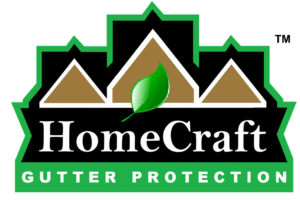Though many houses have gutters, it can be tough to tell what role they play in maintaining your home’s exterior. You may even find yourself wondering if gutters are necessary. A gutter system directs water away from your home, helping prevent mold, mildew, dangerous water buildup and other water damage around your home’s foundation over time.
The This Old House Reviews Team has conducted in-depth research to understand the ins and outs of rain gutter systems and determine the best gutter guard companies. This guide explains what makes gutters necessary and how you can optimize your home’s gutter system for maximum safety and stability.
How Gutters Work
Gutters hang off your roof and catch rainwater as it streams down the surface. Your gutter system then channels that water towards the edges of your roof and into vertical sectionals called downspouts. During dry seasons, your downspouts might empty into a tank or barrel for gardening. In other circumstances, downspouts might empty into a drainage system to move water even further away from your home or into a plastic extension.
When Are Gutters Necessary?
In most cases, rain gutters are not required by law. However, there are some scenarios in which gutters are essential to keep your home in working order. Read about some of these situations below:
- Upward slopes: You’ll definitely want a gutter system if your home sits at the bottom of hills or other upward slopes. Without one, rainwater from these slopes could build up around your home’s foundation rather than moving away from it.
- Clay-rich soil: If your home is near a lot of clay-rich soil, you should also invest in rain gutters. Like red clay soil or clay loam soils, clay-rich soils absorb and retain water when wet. This issue may direct water toward your home’s foundation. Think of the clay as a pipeline that continuously delivers water to the same spot. A gutter system counteracts this problem by draining water into a ground-based gutter line.
- Basement foundation: Without gutters, water can enter your home and cause basement flooding. This could be especially bad if you have a finished basement, as there could be water damage to your belongings that could be easily avoided with a simple gutter installation.
- Little to no overhang: If your roof’s overhang fits close to your home’s siding, frequent rain will cause trenches to form where the water builds up. Often, that rainwater remains close to the foundation once it’s absorbed into the ground, causing severe and costly damage over time. Without gutters, you may also experience water damage to your siding.
When Are Gutters Optional?
Though gutters are usually required or highly encouraged, there are some situations in which gutters are optional. We’ve listed them below.
- Downward slopes: If your home sits on top of a hill, you may have to worry less about gutters. Water is more likely to naturally move away from your home if your landscaping and property feature a lot of downward slopes that point away from your home.
- Concrete: If concrete surrounds your home, you already have a protective barrier from rainwater. Examples of this are sidewalks, driveways, patios, streets, and other concrete structures.
- Climate: A dry, arid climate means less rainwater and puddling. Therefore, homes in regions with a drier climate do not require gutters as much as homes in wetter climates.
- Long overhang: If your home’s overhang is between six to 10 inches long, you may be able to avoid installing a gutter system depending on other factors, such as landscaping and your local climate.
Gutter Problems and Solutions
Though gutters help you prevent significant homeowner headaches and problems, they can also create a few problems. However, these can easily be avoided and addressed. Read over the most common gutter problems and their solutions below.
- Clogging: Because gutters feature large openings, debris like leaves, twigs, pine needles, shingle grit, and pollen can build up over time. Birds and other animals can also build nests inside your gutters. These issues cause water clogs and water damage. However, you can combat this problem with routine cleaning and maintenance or investing in a gutter guard system.
- Ice dams: Many people believe gutters cause ice dams, but this is actually because of your roof and attic. When the snow melts and gets into the eaves of a sloped roof, it can freeze there. This results in an ice dam, or a buildup of ice. Because gutters are next to your eaves, it appears that your gutters are causing the ice dam. Like clogs, routine maintenance of your attic’s ventilation and insulation helps you avoid this issue. Gutter guards with heating elements can also help you combat ice dams.
Our Recommendation
Gutters are necessary in most cases. However, if you want to know whether or not your new construction or home improvement project requires gutters, consider the property’s landscaping features, the climate, the overhang, and the foundation type. If you find that you do need gutters, we recommend that you get at least three quotes from three gutter installers to compare pricing and offerings.
We also encourage you to consider investing in a gutter guard system. Gutter guards block debris from entering your gutters and push it out. Then, you can rake up the fallen debris or knock off standing debris with a broom. We have listed some of our top gutter guard recommendations below.
LeafFilter
LeafFilter offers a comprehensive professional installation process for gutter and guard protection systems. First, the company cleans and prepares your gutters for its stainless steel micro-mesh gutter guard. Then, it installs hidden structural hangers to your fascia board and adds a frame across your gutters to create a platform for its gutter guard to lay on.
This process maximizes stability so that your gutters stay protected for years to come. Micro-mesh gutter guards are also the most efficient type of gutter guard on the market. Their mesh is fine enough that it can combat ice dams in most weather conditions.
Key Features
- Stainless steel guard material
- uPVC frame material
- Metal hanger material
- Customizable sizes
- Rustproof
- Lifetime warranty
LeafGuard
LeafGuard offers homeowners a one-step gutter solution. Professionals remove the existing gutter system and install brand-new gutters and downspouts with built-in gutter protection. The reverse-curve gutter cover uses liquid adhesion to funnel rainwater into the gutter while debris slides onto the ground.
LeafGuard advertises that its downspouts are 30% wider than the industry standard, increasing water capacity to help prevent clogs. Further, the product comes in a dozen colors to match your home’s exterior. The paint finish is resistant to wear and damage and comes with a lifetime warranty.
Key Features
- Reverse-curve design
- Full gutter replacement
- Aluminum frame material
- Twelve color options
- Lifetime finish warranty
- Financing available
FAQs About Gutters
Our Rating Methodology
The This Old House Reviews Team backs up our gutter guard recommendations with a detailed rating methodology to objectively score each gutter guard product and provider. We conduct research by reviewing product specifications and provider website information, speaking with customer representatives, and analyzing customer reviews. We then score each provider against our review standards for specifications, services, reputation, warranties and discounts, payment options, and customer service to arrive at a final score out of 100.
To share feedback or ask a question about this article, send a note to our Reviews Team at reviews@thisoldhousereviews.com.





